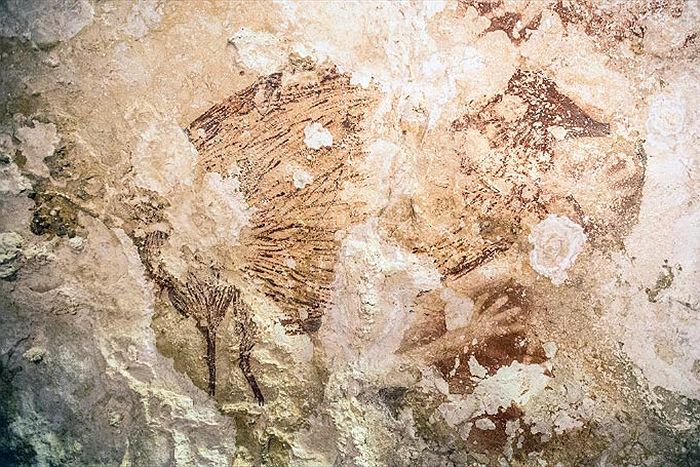
IMF tells rest of Europe to copy George Osborne’s austerity drive
October 9, 2014Acer servis
October 10, 2014- Share

Spot the Babirusa: the 40,000-year-old paintings are made with iron oxide mixed with water(Source: Kinez Riza)
Cave art Cave paintings on the Indonesian island of Sulawesi have been definitively dated as 40,000 years old, researchers report.
The findings put the final nail in the coffin of the idea that Europeans were the first to produce rock art, says archaeologist and geochemist Dr Maxime Aubert of Griffith University.
“A lot of people used to believe that something special happened in Europe and this is where humans became truly modern,” says Aubert, who is the lead author on a paper appearing today in the journal Nature.
He says until now cave paintings at El Castillo in Spain were accepted as the oldest reliably dated rock art — at around 41,000 years old.
But the story has now changed with Aubert and colleagues’ dating of 12 hand stencils and two animal paintings that appear in big limestone caves at Maros, Sulawesi.
“Now we can say that modern humans were making cave paintings in Southeast Asia as well, 40,000 years ago,” says Aubert.
He says the paintings — which include a picture of a babirusa (‘pig-deer’) — are made from iron oxide mixed with water, and were actually discovered in the 1950s, when they were only thought to be just 3000 to 4000 years old.
But dating with a high precision method called U-series dating — the same method used to date the El Castillo paintings — shows otherwise.
“A lot of the paintings there are at least 40,000 years old. This is the same age as paintings in Europe.”
Aubert and colleagues measured the ratio of uranium and thorium isotopes in “cave popcorn” — a layer of tiny stalactite-like growths that covered the art.
“We cannot date the painting itself but we can date the calcium carbonate that has formed on top of the painting,” says Aubert.
Aubert says the findings could mean humans developed art before leaving Africa and brought it with them to Europe and to Southeast Asia. Alternatively, they could have developed art independently in different parts of the world.
“The important aspect of this study is that it enables us to move away from a Eurocentric model,” he says.
Implications for the origins of art
Archaeologist Dr Bruno David of Monash University welcomes the paper.
“The new Sulawesi findings reported by Aubert and colleagues are remarkable and of the utmost significance for understanding our own origins as a cultural species capable of communicating through symbols,” says David, who last year helped put the oldest date so far on rock art in Australia at 28,000 years old.
“For one thing, it takes the debate of the ‘origins of art’ away from Europe, redirecting our gaze to the east of Africa,” he says.
“Australia itself holds fabulous potential for the presence of artworks that are of a similar and even earlier age than that of Sulawesi.”
“The question many of us are asking is: did early modern humans leave Africa with a fully-formed ability to make complex art; or was this ability developed during the journey from Africa to the eastern tip of Asia and onwards to Australia [50,000 years ago]?
“Europe does not feature significantly in this scenario on the origins of art, because it was only colonised by modern humans sometime between 40,000 and 45,000 years ago,” says David.
Of course, he says, if future studies find that humans arrived in Europe earlier, this could “rebalance the equation”.
Geologist Professor Brad Pillans of the Australian National University who has studied Aboriginal engravings on the Burrup Peninsula in Australia agrees the latest paper is “significant”.
“A lot of the thinking about the origins of rock art have centred on Europe for obvious reasons. That’s where the earliest evidence thus far has come from.”
“It really gets you thinking about what this means for rock art and human dispersal.”
How old is Aboriginal rock art?Many people will be forgiven for thinking that Australia has some of the oldest rock art in the world, but the truth there is no reliable dating to show this. Our experts explain the challenges of putting a date on rock art
Email the editor
Use these social-bookmarking links to share Ancient Indonesian rock art rewrites art history.
Use this form to email ‘Ancient Indonesian rock art rewrites art history’ to someone you know:
http://www.abc.net.au/science/articles/2014/10/09/4102672.htm?

